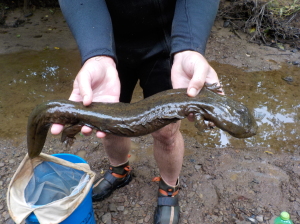Hellbender salamander populations are declining because of poor water quality. Bend your ears to this:

Salamander, what a long body you have! Despite their large size, hellbender salamanders are a rare sight to behold! (via Greg Lipps)
At more than one-foot long, the Hellbender salamander is the largest in North America. Flat, brown, and wrinkled, it has lived at the bottom of streams and ponds for millions of years. But that legacy is threatened, as hellbender populations shrink
Conservationist Greg Lipps says the decline is due in part to decreased water quality. As sediments and pollutants fill the water, salamanders suffocate and die.
Lipps: “When you kill off the hellbender population, they don’t come back. They really are the ultimate water quality monitors.”
To improve water quality and help save the hellbender, we can use the three “r’s”: reducing sediments, replacing streamside forests, and repairing stream banks.
Hear More:
Listen to Greg Lipps describe further causes of the hellbender decline.
Get Schooled:
- Read the story of hellbenders in Ohio with this article by the Columbus Dispatch
The Fine Print:
- This segment is produced with Cornell’s Atkinson Center for a Sustainable Future, and made possible by the Foundation for Pennsylvania Watersheds.




